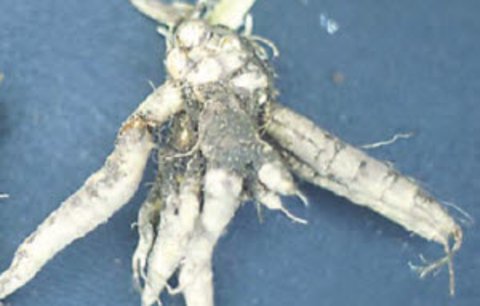-
Death can occur when horses eat
-
Two pounds of water hemlock root per 1,000-pound horse, OR
-
Two to eight pounds of poison hemlock per 1,000-pound horse
-
-
Poison and water hemlock usually grow in wet areas including lowlands, swamps and along waterways.
-
There is no specific treatment for poison or water hemlock poisoning.
-
Herbicides can control poison and water hemlock. Always follow information and grazing restrictions listed on the herbicide label.
-
Never spray or allow herbicide to drift into any water sources.
-
Identifying
Both water and poison hemlocks:
-
Are 2 to 7 feet tall
-
Have hollow stems that branch at the top
-
Are often mottled with purple spots
-
Smell like parsnips or parsley when you crush their leaves
-
Make sure to wear gloves when handling these plants
-
Do not inhale the plants for too long
-
-
Have white flowers that are borne in umbrella-shaped clusters
Water hemlock
-
Roots and stems may produce a yellowish, fragrant oil when cut
-
Leaves have toothed edges and grasp the stem like a celery bunch
Poison hemlock
-
Produces a rosette of leaves near the ground the first year
-
Produces an upright, flowering stalk the second year
-
Leaves have a lacy look and smell like parsnip when you crush them
-
Make sure to wear gloves when handling these plants
-
Do not inhale the plants for too long
-
-
The root looks like a small white carrot
Where is it found?
Both plants grow in swamps, lowlands and usually in water or at the water’s edge (e.g. along streams). However, both plants are also found in drier sites (e.g. along railroad tracks).
Poison hemlock
You can find poison hemlock across most of the United States except in the following areas:
-
North and South Dakota
-
Eastern Montana and Wyoming
Water hemlock
You can find water hemlock from North Dakota south to Texas and East to the Atlantic Ocean except in the Gulf Coast states.
Toxicity
The toxins of water hemlock reside in its roots. Horses can easily pull-up and eat the roots because water hemlock grows in wet areas.
Death can occur if horses eat about two pounds of water hemlock root per 1,000-pound horse.
Signs of poisoning
Horses are most commonly found dead after eating water hemlock.
Rarely, violent seizures are seen. In closely observed cases anxiety and muscle twitching around the lips, nose, face and ears occurred. Seizures and teeth grinding followed these signs. The seizures became longer with frothy saliva, tongue wounds and broken bones in severe cases.
Toxin content in poison hemlock increases as the plant matures and is highest in seeds. While the toxin content declines as the plant dries, it can still be toxic in hay.
Death can occur if a horse eats between 0.2 to 0.8 percent of its body weight in poison hemlock. This amount is equal to 2 to 8 pounds of poison hemlock per 1,000-pound horse.
Signs of poisoning
Within an hour of eating poison hemlock, horses develop:
-
Nervousness tremors
-
Muscle weakness
-
Incoordination
-
Salivation
-
Urination
-
Colic
Signs will then progress to severe depression and laying down. Horses often go down quietly and may have tucked up flanks for a few days after recovery. Seizures may occur, but are less common than with water hemlock.
Treatment
Horses that survive for eight hours after showing signs are more likely to recover unless they have problems from seizures.
There isn’t a specific treatment for hemlock poisoning. Sedation may help the horse if it can be done safely. Charcoal may be useful but is rarely practical in a seizing animal.
Control
Horses don’t find these plants very palatable, but can eat them by accident. Herbicides can help you control water and poison hemlock. Make sure to follow all grazing restrictions and other information on the herbicide label.
Your herbicide options may change, or you may need to take special precautions to protect waterways, if the plants are growing near water. Under no circumstance should you spray or allow herbicides to drift into any waterway, pond or stream.
You can also dig or pull out poison and water hemlock. Make sure to wear gloves when handling these plants.
Fencing your horses out of areas with water or poison hemlock is another control option.
Lifecycle
Water hemlock is a perennial that reproduces by seeds and tuberous roots. A perennial lives for more than two years.
Poison hemlock is a biennial that reproduces by seeds. A biennial lives for only two years.
Reviewed in 2021






